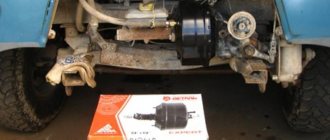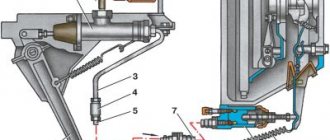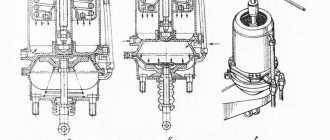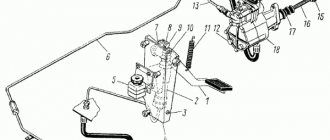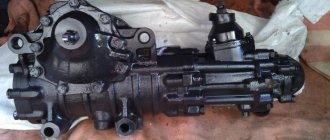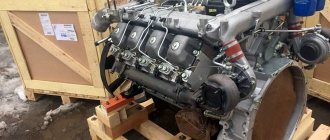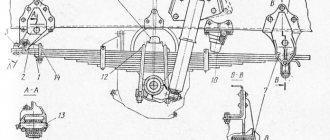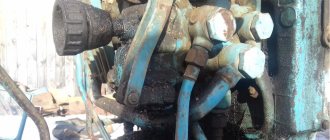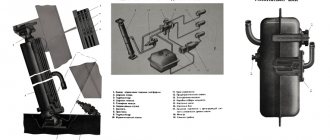Category: KAMAZ
- Pneumohydraulic amplifier design Amplifier housing
- Membrane
- Follower piston
- Air cylinder piston and rod
- Valves and Seals
- The clutch does not disengage, it “drives”
KamAZ vehicles are equipped with a clutch release drive with a pneumohydraulic booster. PGU KamAZ 5320 and other models are necessary to reduce the effort exerted by the driver when disengaging the clutch. The amplifier reduces driver fatigue during long driving.
Pneumohydraulic booster device
The pneumohydraulic booster consists of the following components:
- Metal body;
- Flexible membrane;
- Follower piston;
- Air chamber piston;
- Clutch release rod;
- Inlet valve;
- Exhaust valve;
- Rubber cuffs.
Amplifier housing
The amplifier housing is metal. It consists of two parts. The parts are bolted together. The lugs on one half of the body have internal threads. This eliminates the need to install nuts. Each half of the pneumatic-hydraulic booster housing is equipped with cylinders for installing pistons.
Membrane
The diaphragm is installed at the junction of the parts of the CCGT housing. At the same time, the membrane serves as a sealing gasket. The diaphragm is part of the follower mechanism.
Follower piston
The follower piston is necessary to regulate the supply of compressed air from the vehicle's receiver to the pneumatic cylinder. The piston and flexible diaphragm are subject to pressure from the brake fluid coming from the clutch master cylinder.
Air cylinder piston and rod
The piston is part of a pneumatic power cylinder. The piston is rigidly connected to the working rod. When compressed air pressure is applied, the piston moves, influencing the clutch release rod. You can also read about the KamAZ generator connection diagram.
Valves and Seals
The CCGT is equipped with two valves. The inlet valve is necessary to isolate the power cylinder and the pneumatic line of the car. The outlet is used to communicate the cavity of the power pneumatic cylinder with the atmospheric outlet. Seals are necessary to prevent leakage of brake fluid and compressed air pressure.
Production
The KamAZ-5320 PGU device is suitable for many model modifications of this manufacturer. Most old and new tractors, dump trucks, and military variants are equipped with pneumatic-hydraulic power steering. Modern modifications produced by various companies have the following designations:
- Spare parts for KamAZ (PGU) manufactured by KamAZ OJSC (catalog number 5320) with vertical placement of the tracking device. The device above the cylinder body is used on variations under the index 4310, 5320, 4318 and some others.
- WABCO. CCGT units under this brand are manufactured in the USA and are distinguished by their reliability and compact dimensions. This equipment is equipped with a system for monitoring the condition of the linings, the level of wear of which can be determined without dismantling the power unit. Most trucks with a 154 series transmission are equipped with this type of air-hydraulic equipment.
- Pneumatic hydraulic clutch booster "VABKO" for models with ZF type gearbox.
- Analogues produced at a plant in Ukraine (Volchansk) or Turkey (Yumak).
In terms of choosing an amplifier, experts recommend purchasing the same brand and model that was originally installed on the machine. This will ensure the most correct interaction between the amplifier and the clutch mechanism. Before changing the unit to a new variation, consult a specialist.
Operating principle of KamAZ 5320 PGU
The manufacturer installs a pneumatic-hydraulic booster on the vehicle's clutch housing. Fastening is carried out using bolts. The operating rod of the PSU rests against the clutch release lever.
REFERENCE: The rod at the end has a spherical shape. It rests on the socket of the clutch release lever. This prevents the mechanism from jamming during use.
The operation of the KamAZ 5320 1609510 PGU is carried out as follows:
- Brake fluid is supplied from the clutch master cylinder when the pedal is depressed in the driver's compartment;
- Brake fluid pressure acts on a piston connected to a flexible diaphragm;
- The piston moves to open the intake valve;
- Through the inlet valve, the compressed air pressure from the vehicle's receiver enters the cavity of the power pneumatic cylinder;
- Under the influence of air pressure, the piston of the power cylinder moves, compressing the counter spring and extending the pusher;
- As it extends, the pusher presses the clutch release lever. The clutch disengages;
- When the pedal is returned in the driver's cabin, the brake fluid pressure in the system drops;
- The follower piston and diaphragm move in the opposite direction;
- The intake valve closes, separating the power cylinder and the air line;
- The exhaust valve opens, connecting the interior of the pneumatic cylinder with the atmospheric outlet;
- Under the action of a spring, the piston of the air cylinder returns in the opposite direction, pushing the air mass through the exhaust valve;
- The operating rod moves back, releasing the clutch release lever. At the same time, the clutch is engaged, and the torque from the power unit is transmitted to the input shaft of the gearbox.
IMPORTANT: The degree of movement of the follower piston depends on the brake fluid pressure in the system. Pressure adjustment is carried out by a pedal located in the driver's cabin.
Design features of the PAZ-32053-07, PAZ-4234 clutch
The clutch pressure is generated by the disc pressure spring.
There is no gap between the compression spring and the release bearing, so the inner race of the bearing rotates at the engine speed. During operation, the clutch does not require adjustments.
The clutch pedal rotates in the body bracket on a plastic bushing. The bushing is not lubricated.
In the uppermost position, the pedal is held by spring 3. In this case, the pedal rests against the rubber buffer 2.
The ends of the clutch fork, moving in the hole in the clutch housing and in the bushing, are lubricated through two oil nipples.
Malfunctions of PGU 1609510 and their elimination
If the unit is used correctly, malfunctions rarely occur. To avoid breakdowns, it is necessary to regularly inspect the amplifier. A visual inspection allows you to detect brake fluid leaks and eliminate them. Below are some of the most common faults and how to fix them.
The clutch does not disengage, it “drives”
The problem occurs due to a disruption in the supply of compressed air to the cavity of the power cylinder. Options to solve the problem:
- Check the condition of the inlet valve. Exposure to brake fluid can cause the seal to become soft. It is necessary to replace the pneumatic inlet valve with a known working part;
- Check the condition of the follower piston. If a seal fails, it must be replaced. If the part is highly worn, replace the piston;
- Brake fluid leak. Replace damaged seals;
- Low brake fluid pressure in the system. Remove air from the hydraulic drive.
ATTENTION: The presence of air in the hydraulic drive system may be indicated by a pedal failure in the driver's compartment.
The clutch does not engage completely, it “slips”
The breakdown occurs due to a violation of the air outlet into the atmosphere. Possible causes of failure:
- A blockage in the hydraulic drive prevents the follower piston from returning into place. It is necessary to remove the blockage, fill in new brake fluid and remove air from the hydraulic drive;
- Failure of the exhaust air release mechanism. Air under pressure is not released into the atmosphere, holding the piston of the power cylinder. The exhaust valve needs to be replaced;
- Air cylinder piston jammed. If there is significant wear on the surface, the piston should be replaced;
- Breakage or stretching of the power spring of the pneumatic cylinder. Replace the part.
IMPORTANT: Incorrect operation of the pneumatic-hydraulic cylinder can lead to a traffic accident. If signs of breakdown appear, the unit must be repaired immediately.
Operating principle
When the clutch pedal is pressed under fluid pressure, the KamAZ-5320 PGU device presses on the rod and piston of the follower, after which the structure, together with the diaphragm, moves until the intake valve opens. The air mixture from the vehicle's pneumatic system is then supplied to the pneumatic piston. As a result, the forces of both elements are summed up, which allows you to retract the fork and disengage the clutch.
After the foot is removed from the clutch pedal, the pressure of the supply main fluid drops to zero. As a result, the load on the hydraulic pistons of the actuator and follower mechanism is reduced. For this reason, the hydraulic piston begins to move in the opposite direction, closing the inlet valve and blocking the flow of pressure from the receiver. The pressure spring, acting on the follower piston, moves it to its original position. The air initially reacting with the pneumatic piston is released into the atmosphere. The rod with both pistons returns to its initial position.
Dismantling of PGU KamAZ 5320
If malfunctions occur, it is necessary to disassemble the amplifier 1609510. Disassembly is carried out in the following sequence:
- The half of the body, in which the pneumatic cylinder is located, is rigidly fixed;
- The housing mounting bolts are unscrewed, the clutch release lever drive rod is dismantled;
- The valve is removed from the body;
- Remove the front part of the body;
- The pneumatic cylinder piston and flexible diaphragm are dismantled;
- The retaining ring is removed;
- The valve mechanism reducer is removed;
- Half of the body is removed from the vice;
- The follower piston and the stopper securing it are removed.
After disassembly, the parts of the assembly are washed and inspected for damage. Cracked, stretched, damaged cuffs and seals are replaced with new parts. Check the integrity of the surfaces of the pistons and cylinders. They should not have cracks or chips. The gap between the piston and cylinder must not exceed the permissible limits. If necessary, replace components.
Assembly of the unit is carried out in reverse order. Before installation, parts are treated with Litol lubricant or its analogues. This reduces wear and tear on parts when using the vehicle.
How to bleed the clutch in a MAZ
Adjusting and bleeding the MAZ clutch is a necessary procedure that is sometimes necessary for the quality operation of the vehicle. This is explained by the fact that the unit experiences serious loads, and therefore, when changing the gear, extraneous noise or even crackling may appear.
In any case, if a malfunction is detected, it is recommended to diagnose the condition of the unit as quickly as possible, as well as adjust it or completely bleed the clutch structure. How to bleed the clutch on a MAZ ? This issue needs to be addressed in detail.
Node maintenance
For normal operation of the device, you must perform a number of actions:
- Fill the hydraulic system with high-quality brake fluid that meets the manufacturer's requirements. Poor quality fluid leads to failure of rubber seals;
- Install high-quality spare parts. The components must not be damaged. Cuffs and seals must be of high quality;
- Carry out regular visual inspections of the device. If leaks of working fluid occur, the amplifier should be repaired;
Adjustments
If no serious damage has been found and replacement of structural elements or bleeding of the clutch is not required, you can make adjustments to a number of parts. This will not only extend the life of the clutch assembly, but also improve the operation of the vehicle.
Free play adjustment
The free play of the clutch pedal should not exceed 6-15 mm. You can measure the value using a standard ruler. To do this, you will need to rest it on the floor of the cabin.
If the above values are found to be exceeded, it is recommended to adjust the gap formed between the assembly pusher and the piston. To perform the procedure correctly, you must pull the pedal up all the way, and then:
- Unscrew the nut and loosen it using a wrench.
- Rotate the finger that is responsible for connecting the lever with the eye, which is located at the top.
- Move the pedal from the top position until it touches the piston by an amount of 6-15 mm.
Next, all that remains is to tighten the crown and check the reliability of the fixation.
Adjusting clutch free play
The bearing coupling is one of the important elements in the assembly. The free play should not be more than 4 mm in order to ensure comfortable and quick engagement of the clutch. You can check whether this requirement is met by moving the lever.
To adjust, it is enough to fix the spherical nut of the pneumatic booster pusher and connect the spring to the lever structure.
Clutch pushrod adjustment
The full stroke must be more than 25 mm. Only thanks to this parameter is it possible to ensure complete disengagement of the clutch structure. If the size is smaller, this will not be possible, which will lead to rapid failure of the unit.
You can check the full stroke by pressing the clutch pedal all the way. If everything is in order, then no problems in the form of extraneous sounds or difficulties in performing the action will arise. If the value is not enough, it is recommended to check the liquid level inside the tank and also adjust the free play of the pedal.
Bleeding the MAZ clutch is undoubtedly a difficult procedure, but it can be done independently with an assistant or support. At the same time, it is not at all necessary to contact specialized centers if the car owner knows its structure and is able to solve the problem following the instructions.
